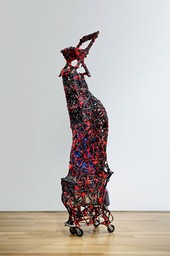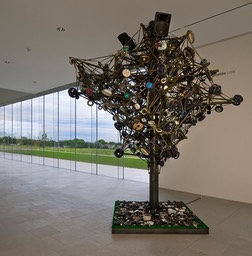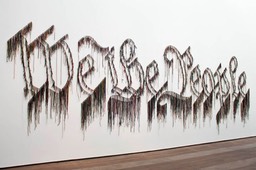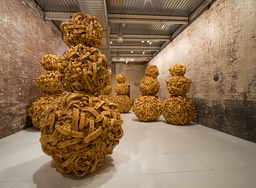Artist Nari Ward and curators Diana Nawi and Tobias Ostrander discuss the exhibition.
BY GEORGE FISHMAN
george@QRartguide.com
Usually, when people are eulogized, they’re not around to enjoy it. But, in the case of Nari Ward, whose retrospective, “Sun Splashed,” was the centerpiece exhibition at the Pérez Art Museum Miami during Art Week, the artist lay just a few feet away behind a curtain, receiving a massage. Those gathered in his honor would hear from him later.
For the first hour, Ward remained prone, flanked by funerary floral arrangements — visible in back-lit silhouette. Associate curator Diana Nawi, who organized the exhibition, joined director Franklin Sirmans for this offbeat performance-lecture on the Saturday after the celebratory opening. Sirmans and Nawi were effective — each in a different style — at evoking the consistent qualities of Ward’s practice.
They emphasized his longtime engagement with immigration, destabilization, history, power struggles, ritual and clichés, and his use of humor. They traced such themes both within the exhibition and — in Nawi’s “eulogy” — for five important works no longer extant.
TOP ARTICLES
Margate Fire Rescue lieutenant shot man who drove
through block party, cops say
“Dearly beloveds,” Nawi began, “we are gathered here today on the occasion of his mid-career retrospective to pay tribute to and to remember the lost work of Nari Ward.”
WORKING ARTIST
Sirmans acknowledged the artist’s work ethic, which he recognized upon first meeting Ward — newly graduated from the City University of New York — in 1992. “Working artist” remains a literal characterization.
“He takes the process of making art as a process of work and of labor,” Sirmans said.
Ward regularly assembles and manipulates industrial and commercial cast-offs —whether fire hoses and baby strollers (Amazing Grace), shoelaces (We The People; Oprama; Live Ball), oil drums (Glory) or shopping carts (Savior; Crusader).
This approach serves as “a means of drawing in the world,” said Nawi. “His works rely on chance and faith through materials, site and process.”
In concisely encapsulating his 20-year trajectory, she cited now-lost works, starting with his complex, site-specific 1991 Skowhegan School residency projects, continuing with his grease-covered hearse at the 1995 Whitney, up through Diamond Gym, created for the Prospect. 1 art fair in New Orleans in 2008.
She noted the multiple layers of meaning with which he successfully imbues wildly diverse found objects. And again, the work ethic. For various reasons, these and other of Ward’s finished pieces have been scrapped or otherwise lost.The range of Ward’s influences — if not his models — encompasses the meticulously rendered, if naïve, Jamaican tourist paintings he saw as a child to the genre-crossing sculptor Lee Bontecou, whom he studied with at Brooklyn College.
Sirmans also invoked David Hammons’ Bliz-aard Snowball Sale, a critique of the art market and Joseph Beuys’ shamanistic social interventions as influences.
When Nawi concluded her eulogy, Ward emerged, wearing a white bathrobe, to answer audience questions.
In an earlier phone interview, he explained that after moving to the United States at age 12, he was acknowledged for his ability to draw realistically, but his parents could barely conceive of art as a viable career. “They didn’t know any artists or grow up around artists, so the artist was always the crazy guy on the outside and always broke.”
Ward initially determined to pursue his talent by studying advertising but soon realized he would rather follow his own artistic lead than someone else’s. Equally important, he had moved from New Jersey to Harlem in the midst of the crack epidemic and AIDS crisis. And there was rampant poverty within his community. These issues were increasingly troubling.
“I wanted to have a conversation with them, and that’s how I started using found objects in my work,” he recalled.
He has knowingly adopted the popular ’60s era Arte Povera notion of making something out of nothing, using commercial materials’ original associations and giving them new life and meaning. Empty lots provided all manner of raw materials for the taking.
“How can I park my concerns in the object with all its questions, with all its ambiguities, with all its complexities that can be a stand-in for the strange anxiety that I have?” he asked. Ironically, few objects better symbolize poverty than the shopping cart, and Ward has used it repeatedly to great effect.
Savior is a prime example. Piled high with discarded materials such as springs, dirt, clocks, plastic bags and a chair on top, it evokes the plight of homeless people, but Ward gives the piece unexpected associations. He created it during a residency at one of the last remaining Shaker communities in the United States.
This 18th century religious order is famous for beautiful crafts — especially furniture. One community leader told Ward, “Well, we really make our work as if an angel was to sit in it.” Thus inspired, Ward said, “I would make a chair where my savior — the thing that I put faith in — would be sitting on top.”
The sculpture then became a performance and video called Pushing Savior, which represented personal activism, “because you can push your own fate. You don’t have to wait for your fate to act.”
Sugar Hill Smiles is another performance piece that combines various threads of Ward’s practice. Conceived as a fundraiser for an arts program in his Harlem neighborhood of Sugar Hill, the artist, dressed in a colorful Jamaican peddler’s costume and equipped with empty tin cans and a manual canning device, wandered the neighborhood. He asked people to look into an open can and simply smile into it.
“Then I closed it up right away, sealed it right in front of them and basically captured the smile.” He is still known in his neighborhood as “the smile man.”
During Ward’s 2013 residency in Rome, a collector was surprised to learn that Ward was Jamaican, because, she naively explained, “Your work doesn’t seem happy.” Ward played off this stereotype by creating the “Jamaican Smiles” and “Black Smiles” series. And whereas his American-born children could only produce “black smiles,” he could smile into either can.
“Nationality and identity were all conflated in that piece in a really interesting way,” he said.
After 9/11, when the United States went through its immediate security alarm and questioned notions of citizenship, duty and authority, Ward studied the Fifth Amendment Miranda rights, noting with regret that these fundamental rights are associated with criminality and “judicial anxiety.”
He decided to downplay the emotional tone and created a homespun version of the text. Homeland Sweet Homeland, which resembles traditional stitchery samplers, assumes an ironic critique but is crafty and approachable.
ACCESSIBILITY
We the People, a wall-mounted text fashioned of dangling shoelaces, juxtaposes notions of collective and individual ideals in a very physical rendering.
“It really was my intention to bring the body into the dialogue,” Ward explained, noting that tying shoelaces is one of the first “crafts” that children learn. The iconic phrase evokes high principles but also their cynical betrayal within the political process. The phrase is universal and lofty, whereas the shoelaces are universal but humble, again lowering the threshold of access.
“I’ve always wanted to figure out how to speak to the guy on the street and the guy in the museum tower. For me that’s the biggest challenge: how to make those communities have an interest in the conversation that I set up.”
Ward’s work bears strong intentionality, but he wants interpretation to remain open-ended. How can art objects inspire deep inquiry without being overly determinative?
POWER
Power systems regularly provide fodder for Ward’s inquiry and bear particular relevance for other artists and audiences of color.
With AfroChase, he appropriates and deconstructs a corporate icon (Chase Bank), inserting Afro hair picks almost like acupuncture needles into the lettering. By fashioning the normally hard and shiny logo out of soft, felt-like weatherproofing material, he further transforms it. Once again, he incites the viewer to question something he thinks he knows.
ECONOMY
Mango Tourist brings the conversation back to Miami, the Caribbean and to economic development. MASS MoCa is an arts center in the city of North Adams, Massachusetts, that once housed the Sprague Electric Company. When Ward was invited to create a project there, he collected thousands of leftover electrical components and combined them with materials and themes evocative of other economic development projects.
“I wanted to make a correlation between art as an economic engine and tourism.”
Tourism is very much a mixed blessing in Jamaica, where all-inclusive resorts keep their guests determinedly busy while isolating them from the local communities, which hardly benefit.
Ward’s sculptural installation consists of snowman-like figures he created by entwining strips of foam that he “suntanned” by scorching them with a torch and “bejeweled” with thousands of abandoned capacitors. And like “Club So-Lay” tourists, they are superficially “busy,” and like snowmen, going nowhere.
CARIBBEAN STEREOTYPES
Happy Smilers and Sun Splashed begin and end the show, creating an unexpected bookend phenomenon that the artist didn’t anticipate. Sun Splashed references his Jamaican uncle’s singing career. Ward adopts the album cover, incorporating the artist’s self-portrait.
Ward had just encountered that collector who was surprised at the artist’s “unhappy” artwork, so he determined, “I’m going to make a happy work, where I’m going to be watering people’s houseplants in Rome.”
He tried posing with a smile, but it didn’t work. It didn’t have the tension. “But when I was stoic, and looked straight ahead, the power came back.” As a result, the piece has more longing than happiness.
Curator Nawi gracefully navigates the regional relevance and engagement of Ward’s work. His exhibition resonates especially well with former student Firelei Báez’s Bloodlines and others currently on view.
Prior to Ward’s conversations with Nawi and his site visits, he held the stereotypical view of Miami as a retirement community — overlaid with Miami Vice.
She brought him to recognize, “My work really resonates here, because it is looking toward the kind of urban centers of the U.S., but then it’s rooted in a kind of tendril of the Caribbean and my memory of Jamaica and even my dislocation from place.”
He began with some trepidation, not wanting to be coined a “Jamaican artist.”
“I’ve always tried to push back against labels. She [Nawi] is smart enough to set up this dynamic where it’s not about being in the U.S. or Jamaica, but about this idea of belonging as a kind of question mark and how we all feel like our feet are in two places at the same time. And that part comes out in this show — this sense of trying to fit one’s selfness into a place.”
That challenge couldn’t be more relevant — to Miami and the world today.
Listen to audio: bitly.com/NariWardAtPAMM



